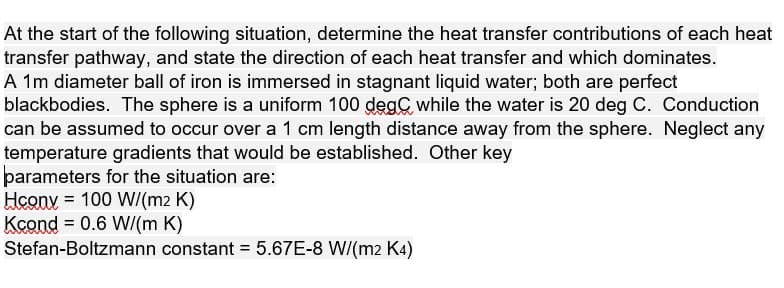At the start of the following situation, determine the heat transfer contributions of each heat transfer pathway, and state the direction of each heat transfer and which dominates. A 1m diameter ball of iron is immersed in stagnant liquid water; both are perfect blackbodies. The sphere is a uniform 100 degC while the water is 20 deg C. Conduction can be assumed to occur over a 1 cm length distance away from the sphere. Neglect any temperature gradients that would be established. Other key þarameters for the situation are: Hcony = 100 W/(m2 K) Kcond = 0.6 W/(m K) Stefan-Boltzmann constant = 5.67E-8 W/(m2 K4)
At the start of the following situation, determine the heat transfer contributions of each heat transfer pathway, and state the direction of each heat transfer and which dominates. A 1m diameter ball of iron is immersed in stagnant liquid water; both are perfect blackbodies. The sphere is a uniform 100 degC while the water is 20 deg C. Conduction can be assumed to occur over a 1 cm length distance away from the sphere. Neglect any temperature gradients that would be established. Other key þarameters for the situation are: Hcony = 100 W/(m2 K) Kcond = 0.6 W/(m K) Stefan-Boltzmann constant = 5.67E-8 W/(m2 K4)
Principles of Heat Transfer (Activate Learning with these NEW titles from Engineering!)
8th Edition
ISBN:9781305387102
Author:Kreith, Frank; Manglik, Raj M.
Publisher:Kreith, Frank; Manglik, Raj M.
Chapter4: Numerical Analysis Of Heat Conduction
Section: Chapter Questions
Problem 4.11P
Related questions
Question

Transcribed Image Text:At the start of the following situation, determine the heat transfer contributions of each heat
transfer pathway, and state the direction of each heat transfer and which dominates.
A 1m diameter ball of iron is immersed in stagnant liquid water; both are perfect
blackbodies. The sphere is a uniform 100 degC while the water is 20 deg C. Conduction
can be assumed to occur over a 1 cm length distance away from the sphere. Neglect any
temperature gradients that would be established. Other key
parameters for the situation are:
Hconv = 100 W/(m2 K)
Kcond = 0.6 WI(m K)
Stefan-Boltzmann constant 5.67E-8 WI(m2 K4)
%3D
Expert Solution
Step 1
Given
Temperature, T1 = 100oC
T2 = 20oC
Thickness, L = 1 cm
Diameter, d1 = 1m
Thermal conductivity, k = 0.6 W/mK
Find
Heat transfer rate in each mode
Trending now
This is a popular solution!
Step by step
Solved in 2 steps

Knowledge Booster
Learn more about
Need a deep-dive on the concept behind this application? Look no further. Learn more about this topic, mechanical-engineering and related others by exploring similar questions and additional content below.Recommended textbooks for you

Principles of Heat Transfer (Activate Learning wi…
Mechanical Engineering
ISBN:
9781305387102
Author:
Kreith, Frank; Manglik, Raj M.
Publisher:
Cengage Learning

Principles of Heat Transfer (Activate Learning wi…
Mechanical Engineering
ISBN:
9781305387102
Author:
Kreith, Frank; Manglik, Raj M.
Publisher:
Cengage Learning